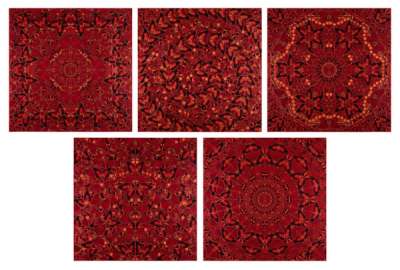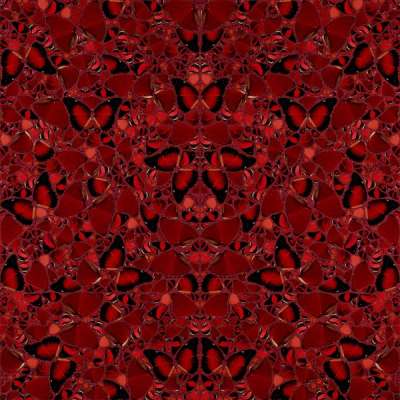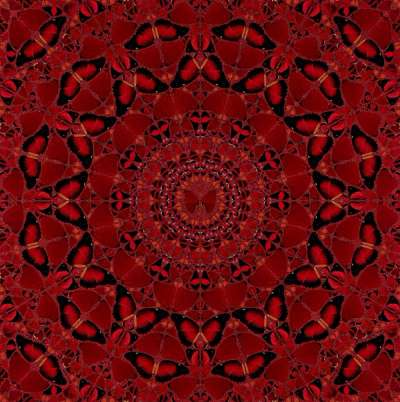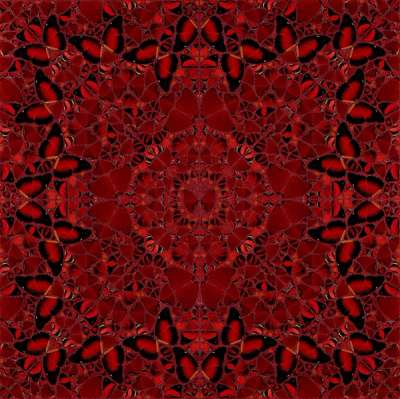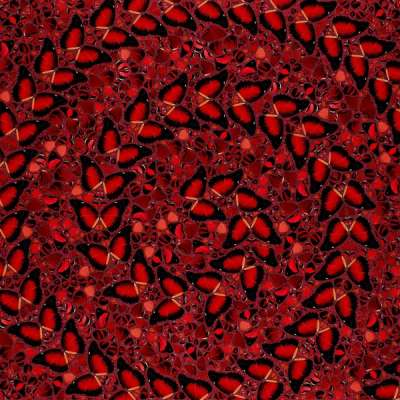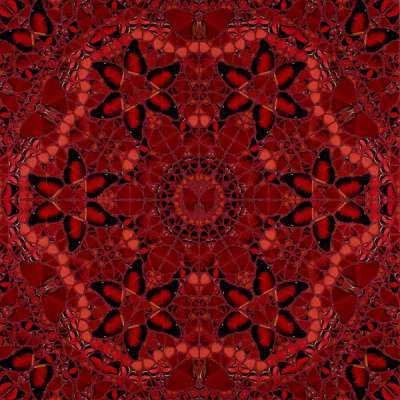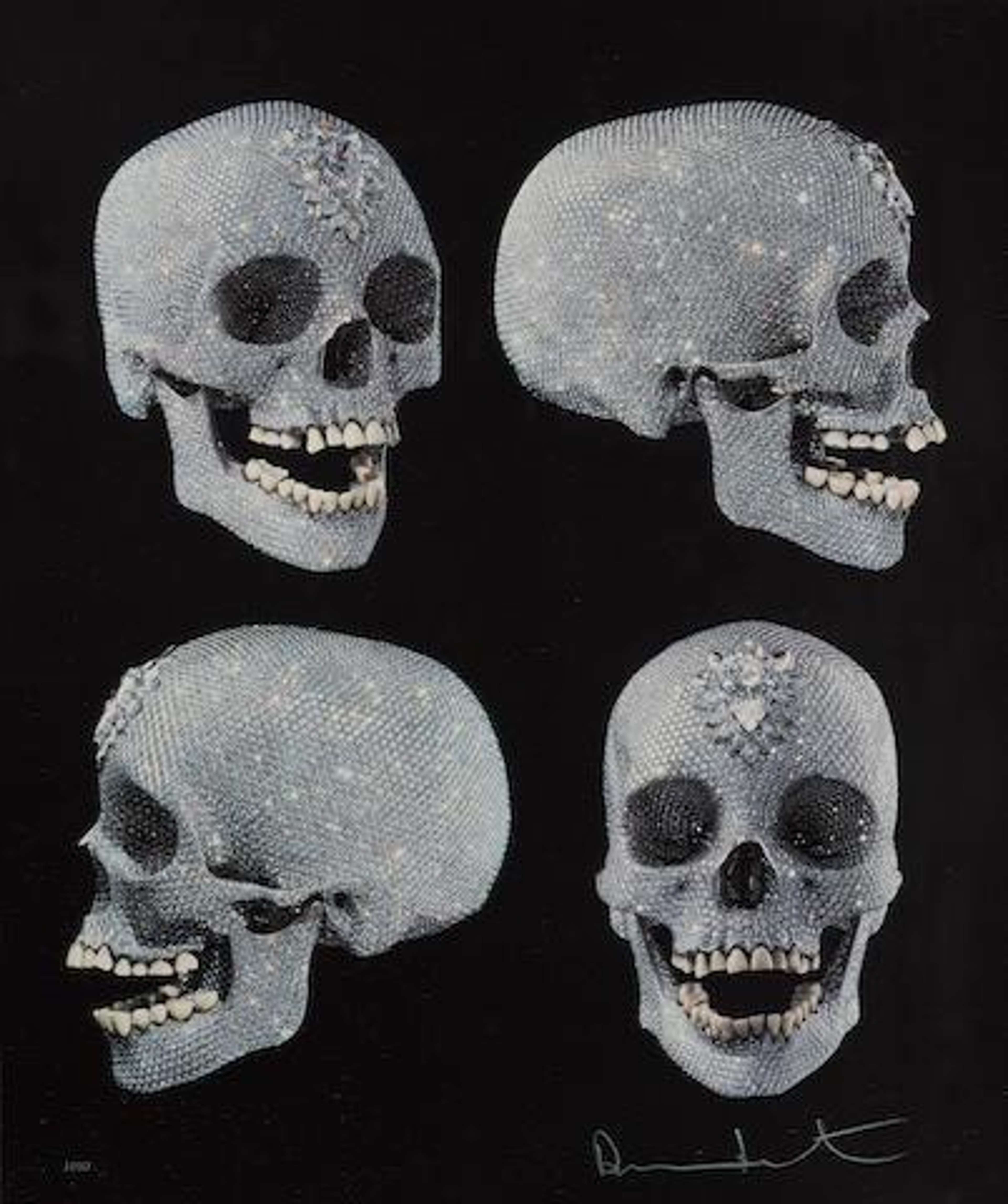 H10 The Empresses (complete set) © Damien Hirst 2022
H10 The Empresses (complete set) © Damien Hirst 2022
Damien Hirst
673 works
Few names evoke as much debate, admiration and controversy as Damien Hirst. From formaldehyde-soaked animals to intricate diamond-encrusted skulls, Hirst’s oeuvre continually challenges the conventional boundaries of art, commerce, and philosophy. Since bursting onto the London art scene in the late 1980s as a leading figure of the Young British Artists movement, Hirst has consistently pushed the envelope, provoking strong reactions and raising fundamental questions about the nature of art and its place in society: H10 Empresses is a great example of this major theme in his work.
Damien Hirst’s H10 The Empresses was released as a print and NFT series for HENI Editions
 H10-5 Taytu Betul © Damien Hirst 2022
H10-5 Taytu Betul © Damien Hirst 2022The crimson red, orange and black butterfly compositions are offered in 5 different arrangements, and are done in laminated giclée on aluminium composite with screen printed glitter. Hirst's choice of a red hued palette aligns with the colour's historical significance and associations with power and royalty.
The name 'Empresses' has a double-entendre, referencing both the butterfly species and the political position
 H10-1 Wu Zetian © Damien Hirst 2022
H10-1 Wu Zetian © Damien Hirst 2022This series represents a fresh phase in Hirst's study of the butterfly as a medium. To the artist, these creatures have come to represent freedom, spirituality, and the fleetingness of existence and mortality.
H10-3 Theodora is the only composition that is asymmetrical
 H10-3 Theodora
H10-3 TheodoraWhile most works are arranged in a mandala-like pattern, Theodora's main butterfly is slightly off-centre within the composition. HENI editions has stated this arrangement creates "a formation reminiscent of the female gender symbol", an apparent nod to some of Theodora’s landmark feminist policies, such as the prohibition of the trafficking of girls and the amendment of Byzantine divorce laws to give women additional rights.
Each print is named after a notable Empress throughout history
 Image © CC BY-SA 4.0 and Petar Milošević / Mosaic of Empress Theodora in the Basilica of San Vitale
Image © CC BY-SA 4.0 and Petar Milošević / Mosaic of Empress Theodora in the Basilica of San VitaleH10-1 Wu Zetian
Empress Wu Zetian (624-705 AD) was the only woman to rule as a Chinese emperor in her own right, and stands as one of the most powerful and controversial figures its history. Born into a noble family, Wu Zetian began her journey to power as a concubine of Emperor Taizong. Upon his death, she married his successor, Emperor Gaozong, quickly establishing herself as a key advisor. After Gaozong's passing, Wu Zetian manoeuvred into a position of supreme power, first as regent for her young son and then by assuming the title of Emperor herself -- founding the Zhou Dynasty and interrupting the Tang Dynasty's rule. Her reign was marked by vast territorial expansion, significant reforms in administration and law, and the promotion of Buddhism over Daoism as the state religion.
H10-2 Nūr Jahān
Empress Nūr Jahān (1577–1645) was one of the most influential women of the Mughal Empire, known not only for her beauty but also for her astute political acumen and administrative abilities. Born as Mehr-un-Nissa in Persia, she moved to India at a young age. She first married a nobleman, but after his untimely death was brought to the Mughal court where she became the twentieth wife of Emperor Jahangir in 1611. Nūr Jahān, which means 'Light of the World', became an indispensable power behind the throne during Jahangir's reign. She was involved in state matters, issued imperial decrees and even had coins minted in her name. Her patronage was influential in shaping art and architecture. Empress Nūr Jahān's legacy is not just as a consort, but as a co-sovereign who significantly impacted the cultural and political landscape of her time.
H10-3 Theodora
Empress Theodora (circa 500–548 AD) was one of the most powerful and influential women of the Byzantine Empire, known for her rise from humble beginnings to the heights of imperial power. Born into a low social class in Constantinople, Theodora began her career as an actress, a profession considered disreputable at the time. Her intelligence and charm caught the attention of the future Emperor Justinian I, who married her despite societal disapproval. As empress, Theodora became a key advisor and co-ruler with Justinian, playing a pivotal role in shaping the empire's politics and religious affairs. She is particularly remembered for her advocacy of women's rights; her influence led to significant reforms that improved women's status in Byzantine society. When the Nika riots threatened Justinian's rule, it was Theodora's courage and counsel that fortified him to stand firm, saving his reign. Her life, marked by tenacity, political acumen, and compassion, left an indelible mark on Byzantine history.
H10-4 Suiko
Empress Suiko (554–628 AD) was the first recorded empress regnant of Japan and a pivotal figure in the early history of the Japanese state. Ascending to the throne in 592, she reigned during a transformative period that saw the solidification of the centralised Yamato state and the spread of Buddhism throughout Japan. With the support of her regent and nephew, Prince Shōtoku, Suiko promoted Buddhist teachings and practices, leading to the construction of several temples. Empress Suiko's reign laid the foundation for Japan's subsequent political and cultural development, and she is celebrated both for her leadership and her role in fostering Buddhist and Confucian influences.
H10-5 Taytu Betul
Taytu Betul (c. 1851–1918) was an Ethiopian empress consort, renowned for her political sagacity, diplomatic prowess and integral role in the anti-colonial resistance of Ethiopia during the late 19th and early 20th centuries. Born into a noble family of the northern Ethiopian region, she was well-educated and fluent in multiple languages. In 1883, she married Emperor Menelik II, becoming his third wife and most influential advisor. Taytu was a strategic thinker and a military tactician, whose prominence was evident during the First Italo-Ethiopian War, Ethiopia's victorious defense against Italian colonisation. Beyond her military achievements, Taytu was instrumental in founding Addis Ababa, Ethiopia's current capital. As an influential figure, she championed the preservation of Ethiopian culture and Orthodox Christian faith amidst pressures of modernisation and foreign influence.
Hirst was inspired by an antique encounter in his studio
 Image © X @HENI / Damien Hirst standing in front of his Empress series 2022
Image © X @HENI / Damien Hirst standing in front of his Empress series 2022As told by HENI editions, Hirst got the idea to use butterflies in his work from an encounter in his studio with the intricate patterns of a Victorian tea tray. Hirst said "I found an old Victorian tea tray, which had the base of it under glass. Somebody in Victorian times had put butterflies underneath it. And I just thought: ‘Wow, that’d look great if you did them big, they’re like kaleidoscopes.’"
Butterflies are a reccurring motif in Hirst's work
 The Souls I (chilli red, oriental gold) © Damien Hirst 2010
The Souls I (chilli red, oriental gold) © Damien Hirst 2010Hirst's use of butterflies, dead or alive, has become a hallmark of his artistic journey. In his 1991 installation, In and Out of Love, he juxtaposed the vibrancy of living butterflies with the starkness of their deceased counterparts on canvases, delving into themes of life, death, ephemerality and rebirth. His Kaleidoscope series displays intricate patterns of butterfly wings, reminiscent of stained-glass artistry, encouraging spiritual and aesthetic contemplations. Through these works, Hirst invites observers into profound reflections on existence, nature's role in art and its intersection with the commercial realm. Hirst has stated: "I love butterflies because when they are dead they look alive."
The glitter on the artwork adds to the idea of fleeting movement by the butterfly wings
In the series, the wings are placed against a background of red glitter, which only adds to the glamour and contributes to the illusion of movement of the butterflies.
These works are reminiscent of Buddhist mandalas or Gothic rose windows
 Cathedral, Santiago De Compostela © Damien Hirst 2007
Cathedral, Santiago De Compostela © Damien Hirst 2007This is not the first of Hirst's series to touch on this imagery. His Cathedral and Kaleidoscope series had previously explored the repetition of pattern and movement.
The works were also released as NFTs
 H10-2 Nūr Jahān © Damien Hirst 2022
H10-2 Nūr Jahān © Damien Hirst 2022When Hirst first released The Empresses, collectors had two options: they could buy the physical prints outright or acquire a "HENI Editions NFT Deed," allowing them to defer obtaining the print for up to three years. This iteration of the HENI NFT offered the advantage of later exchanging the digital for the tangible artwork. Additionally, it enabled collectors to transfer their rights to the print by trading the NFT, providing the utmost flexibility for them.
This series was a special edition, available for a short time
 H10-4 Suiko © Damien Hirst 2022
H10-4 Suiko © Damien Hirst 2022The prints were available to purchase on HENI for only one week, from 28th January 2022 until Friday 4th February 2022. Ultimately, the final number of editions created was dictated by demand during this time period.


